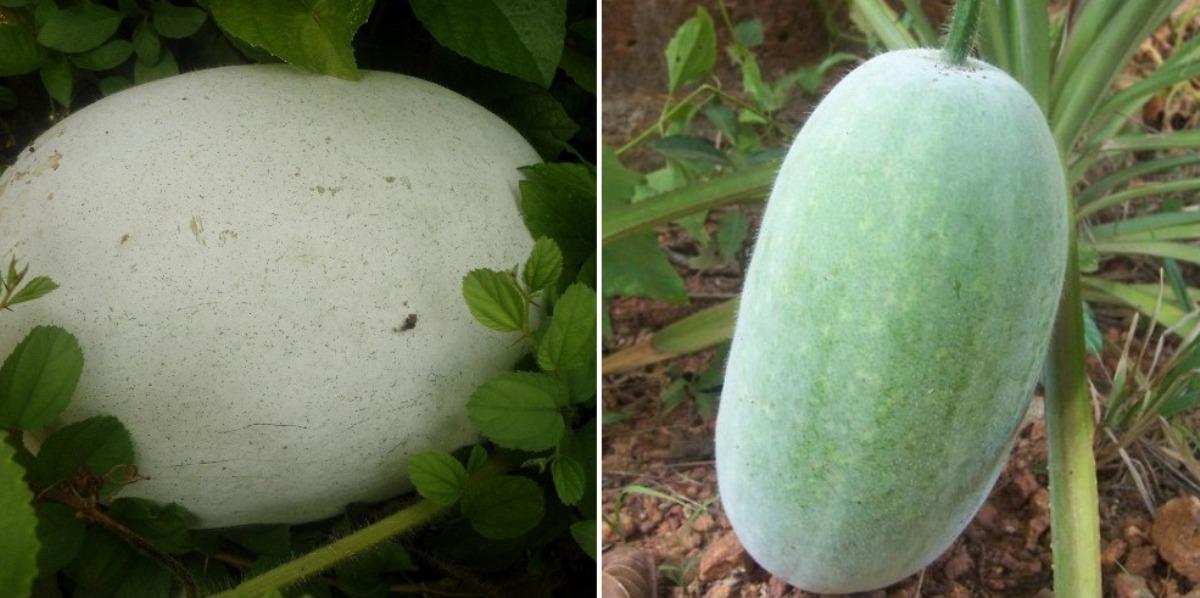
Cultivation of Ash Gourd (Benincasa hispida)
General Information
- Botanical Name: Benincasa hispida.
- Common Names: Ash Gourd, Wax Gourd, Winter Melon, Petha (Hindi), Neer Poosanikai (Tamil), Boodida Gummadi (Telugu).
- Family: Cucurbitaceae.
- Origin: Native to Southeast Asia.
- Uses: Widely used as a vegetable and for making sweets like petha. Medicinally, it is valued for its cooling and diuretic properties.
Origin, Area, and Distribution
- Origin: Believed to have originated in Southeast Asia and China.
- Area: Grown extensively in tropical and subtropical regions, including India, China, Indonesia, and the Philippines.
- Major Growing States in India: Uttar Pradesh, Madhya Pradesh, Tamil Nadu, Andhra Pradesh, Karnataka, and Maharashtra.
Climate
- Temperature: Warm and humid conditions are ideal. Optimum temperature range: 24–30°C.
- Rainfall: Requires moderate rainfall; sensitive to waterlogging.
- Season: Suitable for both summer and rainy seasons.
Soil
- Well-drained sandy loam to clay loam soils with high organic matter.
- pH Range: 6.0–7.5.
- Avoid heavy and saline soils.
Improved Varieties
- CO-1: High-yielding variety with uniform-sized fruits.
- Arka Sumeet: Medium-sized fruits with high productivity.
- Punjab Komal: Early-maturing, suitable for North Indian plains.
- Pusa Ujwal: High-yielding variety developed by IARI.
- Indu: A hybrid variety with uniform fruit quality.
Seed Rate: 2–3 kg per hectare. Large seeds with a high germination rate
Cultivation Practices
Time of Sowing
- Kharif Season: June–July (onset of monsoon).
- Rabi Season: January–February (in areas with mild winters).
- Summer Season: February–March.
Land Preparation
- Plow the field 2–3 times to achieve a fine tilth.
- Incorporate 10–15 tons of well-decomposed farmyard manure (FYM) per hectare during the final plowing.
Sowing Methods
- Seed Rate: 3–4 kg per hectare.
- Spacing:
- Row-to-row: 2.0–2.5 m.
- Plant-to-plant: 0.75–1.0 m.
- Planting Method: Seeds are sown directly in pits or ridges.
Seed Treatment
- Treat seeds with fungicides like Carbendazim (2 g/kg of seed) to prevent fungal diseases.
- Soaking seeds in warm water for 12–24 hours improves germination.
Fertilizer Requirements (Per Hectare)
- Basal Dose:
- Nitrogen (N): 40 kg.
- Phosphorus (P₂O₅): 60 kg.
- Potassium (K₂O): 40 kg.
- Top Dressing:
- Additional 40 kg of nitrogen in two splits during vine elongation and flowering stages.
Irrigation
- Requires regular irrigation to maintain soil moisture, especially during dry spells.
- Frequency:
- Summer: Every 4–5 days.
- Rainy season: As required to avoid waterlogging.
- Critical stages: Flowering and fruit development.
Training and Pruning
- Provide trellises or stakes for better vine management, fruit quality, and pest control.
- Prune side shoots and remove old or diseased leaves.
Weed Management
- Perform 2–3 hand weedings during the initial growth stages.
- Mulching with straw or plastic sheets reduces weed growth and conserves moisture.
Pest and Disease Management
- Pests:
- Fruit Fly: Use pheromone traps and neem-based sprays.
- Aphids: Spray Imidacloprid or neem oil.
- Diseases:
- Powdery Mildew: Treat with sulfur-based fungicides.
- Downy Mildew: Use Mancozeb or Metalaxyl sprays.
- Fruit Rot: Improve drainage and apply copper-based fungicides.
Harvesting and Yield
- Harvesting:
- Harvest when fruits are mature, firm, and covered with a whitish wax coating.
- Typical harvest time: 90–120 days after sowing.
- Yield: 20–25 tons per hectare under good management practices.
Physiological Disorders
Fruit Cracking: Cause: Sudden changes in soil moisture. Management: Maintain consistent irrigation practices.
Poor Fruit Set: Cause: High temperatures or lack of pollinators. Management: Enhance pollination using hand pollination or by attracting bees.

